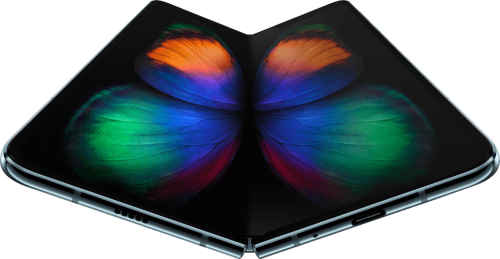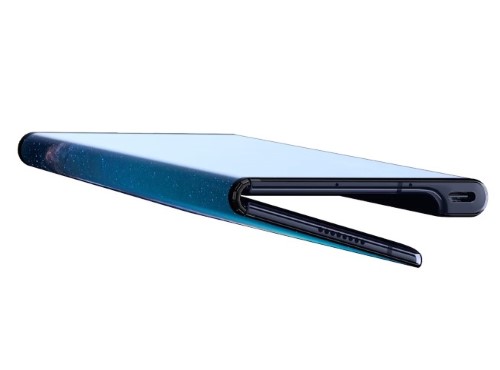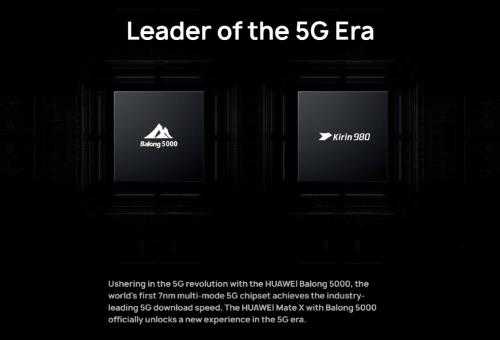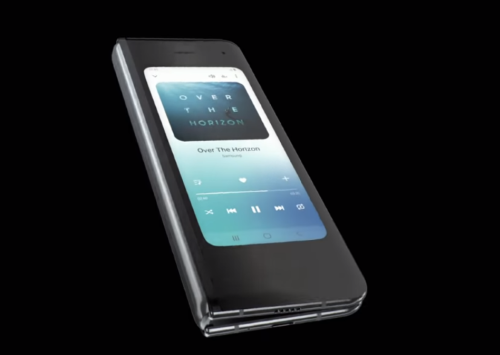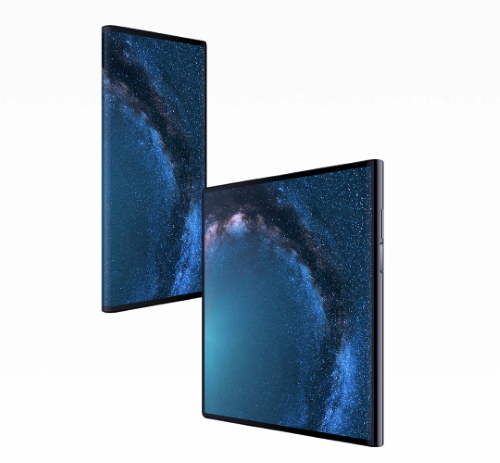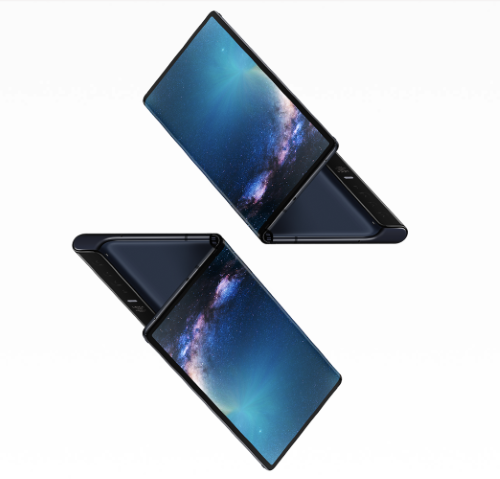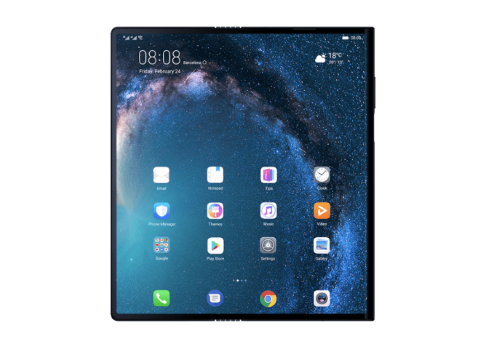
There are at least two big headlines from this year’s Mobile World Congress: 5G and smartphones with folding displays. The latter of which has been fantasized and dreamed of for years by consumers and smartphone makers alike. This year, we see that elusive dream become a little more mainstream as two of the smartphone world’s titans, the Samsung Galaxy Fold and the Huawei Mate X battle to see who did it better.
| Samsung Galaxy Fold | Huawei Mate X | |
|---|---|---|
| SoC | Qualcomm Snapdragon 855 (7nm) 1 x 2.84 GHz Kryo 485 3 x 2.43 GHz Kryo 485 4 x 1.80 GHz Kryo 485 Adreno 640 GPU | HiSilicon Kirin 980 (7nm) 2 x 2.60 GHz Cortex-A76 2 x 1.92 GHz Cortex-A76 4 x 1.80 GHz Cortex-A55 Mali-G76 MP10 GPU |
| Memory & Storage | 12 GB RAM LPDDR4X 512 GB UFS 3.0 internal storage | 8 GB RAM 512 GB internal storage Nano memory card slot |
| Display/s | Dual-screen: inward folding main screen + cover screen Cover (small display): 4.6" 21:9 (1680 x 720) Super AMOLED Internal (large display): 7.3" 4.2:3 (2048 x 1536) Dynamic AMOLED | Single outward folding AMOLED screen Folded (wide side): 6.6" 19.5:9 (2480 x 1148) Folded (short side): 6.38" 25:9 (2480 x 892) Unfolded: 8" 8:7 (2480 x 2200) |
| Front Camera/s | Cover: 10 MP f/2.2 Front: 10 MP f/1.9 + 8 MP f/2.2 Dual Pixel, Live Focus | (see Rear Camera/s) |
| Rear Camera/s | 12 MP 1.4µm, Dual Pixel, dual aperture (f/1.5 or f/2.4), OIS, main lens 16 MP 1.0µm, f/2.2, 123-degree wide-angle lens 12 MP 1.0µm, f/2.4, OIS, 2x telephoto lens | Quad lens setup (?) developed with Leica |
| OS | Android 9.0 Pie OneUI | Android 9.0 Pie |
| Battery & Charging | 4,380 mAh (combined) | 4,500 mAh (combined) |
| Wireless Connectivity | 802.11 a/b/g/n/ac 2x2 MU-MIMO BT 5.0 LE NFC GPS/GLONASS/Galileo/BDS LTE & 5G versions planned | 802.11 a/b/g/n/ac Balong 5000 5G modem Quad 5G antenna design 4.6 Gbps at sub-6GHz mmWave support |
| Ports | USB Type-C | USB Type-C |
| Dimmensions | N/A | 11mm thick (folded) 5.4mm thick (unfolded) |
| Availability & Pricing | US: April 26 ($1,980) Europe: May 3 (€2,000) | mid-2019 (€2,299) |
It’s a fairly simple concept on the surface: It’s just like a smartphone, but with a folding screen. The possibilities are many, with the main one being having a larger screen at a pocketable size. But as we’ll see, Huawei and Samsung have taken different approaches to this.
THE PERFORMANCE
Both Samsung and Huawei have taken their existing hardware found on the Galaxy S10+ and Huawei Mate 20 Pro and put it in these next-gen devices. The Qualcomm Snapdragon 855 is fresh out of the oven and the Galaxy S10 series will debut them soon. On the other hand, Huawei’s in-house developed HiSilicon Kirin 980 has already been with us since last year’s trio of Mate 20 devices.
These octacore powerhouses should pack enough performance for these first-gen foldable display smartphones. But, given that the Kirin 980 was already trading blows with the previous-gen Snapdragon 845, Samsung’s choice is most likely to be faster. The Samsung Galaxy Fold also has 4GB more RAM than the Huawei Mate X, making it better for multi-tasking where these foldables are supposed to excel at.
We’re yet to see if Huawei can or will squeeze more performance out of the Kirin 980 given the larger footprint and potential cooling capacity, and/or if they’ll offer other variants with more RAM. But for now, we’ll have to give this victory to Samsung.
THE CAMERAS
The camera setup on the Huawei Mate X is fairly straightforward. Housed in a sidebar to the right side of the device is the triple camera setup. Huawei has quoted the Mate X to have a quad camera set up, but the pictures say otherwise. Anyway, Huawei hasn’t specified what camera sensors are used, but its a fair assumption that one of them will be the 40 MP sensor from the Mate 20 Pro plus a telephoto and ultra-wide angle one.
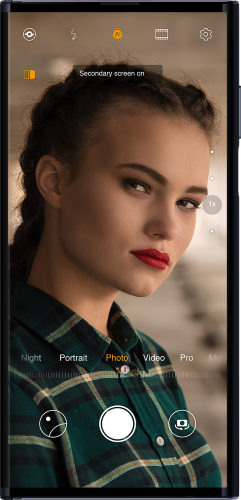
Regular photos 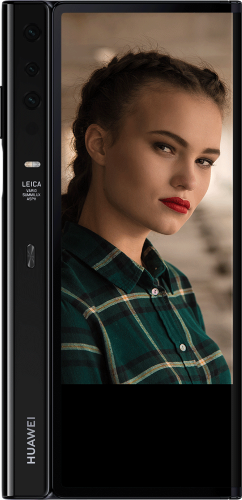
Selfie mode
Huawei’s implementation is very practical and elegant. With the Huawei Mate X folded, you can use the folded half display next to the sidebar to take selfies. For regular photos, you can just flip the device and use the wider folded half of the display as the viewfinder.
Samsung’s approach is a bit more complicated. Folded, there’s a 10 MP f/2.2 camera above the smaller cover screen. Unfolded, it’s a 10 MP f/1.9 + 8MP Live Focus dual-lens setup on the notch on the top right of the large internal screen. These, we’re betting, are the same front cameras found on the Galaxy S10+. For the main cameras at the back, it’s a triple lens setup comprised of a 12 MP main sensor, a 16 MP ultra-wide angle sensor, and a 12 MP telephoto lens. Again, these are probably the same ones on the Galaxy S10 and S10+.
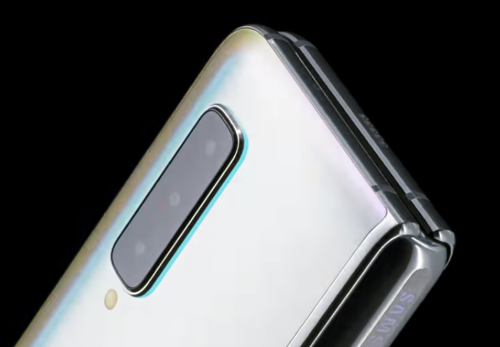
Main triple-cameras 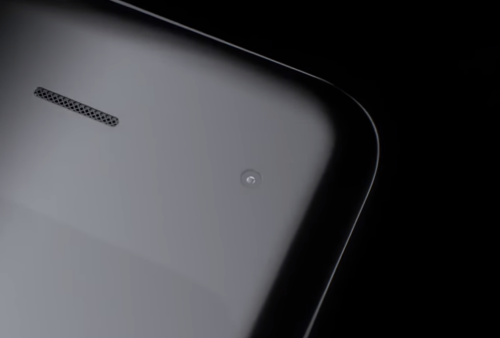
Cover camera 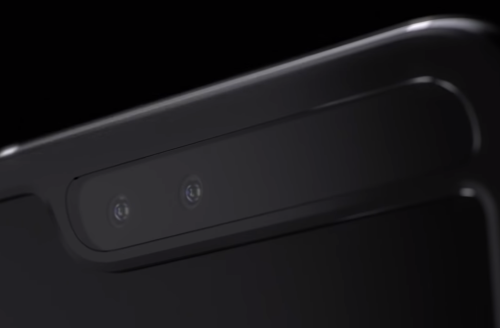
Internal dual-cameras
I have to say, I like Huawei’s simpler and cleaner approach more. Samsung seems to have trapped themselves with their inward folding mechanism, thus requiring them to put in more cameras than Huawei. While I have no doubt that the Galaxy Fold will take as impressive photos as its Galaxy S10 siblings, Huawei’s recent advances in computational photography should put them on par, if not ahead of Samsung.
THE BATTERY AND CHARGING
Both Samsung and Huawei have crammed large batteries into their foldables. Interestingly, both companies have opted for dual-battery solutions similar to what Apple did with the iPhone X.

Based on what Samsung has shown off with the Galaxy S10 range, the Galaxy Fold will have 15W wired and 15W wireless fast charging. This, I feel, has been Samsung’s weak point so far, considering that other smartphone makers have been pushing charging speeds faster and faster.
On the other side of the spectrum is Huawei’s monstrous 55W SuperCharge wired charging. Also having a slightly bigger battery, Huawei wins this round unless Samsung pulls out a much, much faster charging solution soon. Or they could at least throw in a wireless charging pad in the box.
THE NEXT BEST THING: 5G
With both company’s introducing the best of their best, it’s no surprise that 5G makes its way into these devices as well. Promising multiple times better speeds and improved latency compared to existing 4G, 5G will be the way forward.
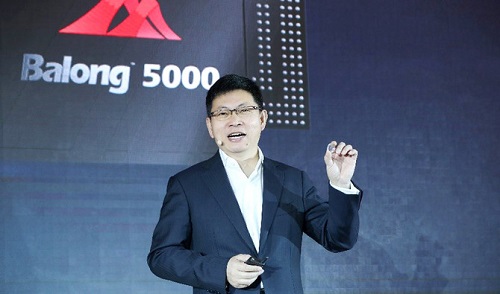
We’ve already seen Huawei’s multi-mode Balong 5000 5G modem back in late January. The Balong 5000 really puts into perspective just how much Huawei has invested in the 5G network and just how big their role is in telecommunications. Just some impressive numbers for the Balong 5000 are 4.6 Gbps download speeds using sub-6 GHz 5G frequency bands, and up to 6.5 Gbps on the mmWave high frequency bands. In tandem with the in-house developed HiSilicon Kirin 980, the Mate X is truly a device Huawei can be proud to call its own.
Samsung is also planning a 5G version of the Galaxy Fold. Given the Snapdragon 855 mobile platform that it already sits on, Samsung will most likely tap Qualcomm’s Snapdragon X50 5G modem. According to Qualcomm’s own specifications, the X50 also supports the mmWave spectrum, but download speeds top out at 5 Gbps. Needless to say, Huawei flexes its muscles here and edges out Qualcomm, and therefore Samsung.
THE DISPLAY AND FOLDING DESIGN
Now for the main event: the displays. As I’ve already hinted earlier, I’m admittedly a much bigger fan of the Huawei Mate X’s display implementation than of the Galaxy Fold’s.
Between the two, the Galaxy Fold is undoubtedly going to have the better main display. Fresh off debuting on the Galaxy S10 series, the Dynamic AMOLED display tech makes its way here in a larger 7.3″ 4.2:3 format. If it’s anything like the Galaxy S10 display, it should support HDR10+ and an insane 1200 nits of peak brightness. There’s a notch on the top right corner which houses a dual camera setup.
Folded, you’re going to be using the 4.6″ Super AMOLED display which is surrounded by huge bezels. Going from the small cover display to the inner display should be smooth as Samsung has worked with Google in developing its OneUI skin to take advantage of the folding setup. Three-way multi-tasking is now possible thanks to the larger screen so the Galaxy Fold will be very enticing to power users.
As for the Mate X, it uses “just” one AMOLED display which folds outwards. It is bigger, however, at 8 inches and has a higher resolution than what’s on the Galaxy Fold. It’s not yet revealed what Huawei has done to its EMUI to accommodate the new folding mechanism, but since Google is working with app developers themselves, there shouldn’t be too much to worry about there.
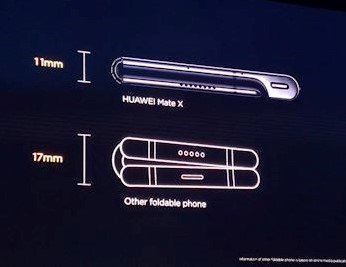
Huawei’s solution is impressively thin, at just 11 mm when folded, and 5.4 mm at its thinner parts when unfolded. They know the feat they’ve achieved here and they’ve already poked fun at the “other foldable phone” in their presentation. According to Huawei, the “Falcon hinge” on the Huawei Mate X allows it to fold more flatly than the Galaxy Fold.
CONCLUSION
Huawei definitely has the sexier product here. The sidebar design is a stroke of genius because it not only allows Huawei to fit critical components somewhere, but also gives one of the folds a place to fit in perfectly.
The Galaxy Fold meanwhile is left looking like the more unpolished product. Perhaps there’s an crucial reason why Samsung went with their inward fold design. Maybe their expertise in display technology has led them to a conclusion that this is a more robust long-term solution than a singular outward folding AMOLED panel. Regardless, the Mate X looks like a better party trick than the Galaxy Fold.
Whichever you opt for, bleeding edge tech like this comes at wallet-bleeding prices. Costing upwards of USD 2,000, both the Mate X and the Galaxy Fold cost significantly more than today’s most expensive flagships. To put it in terms everyone else has said, “It’s more expensive than my first car.”
What do you think? Between Samsung’s inward folding Galaxy Fold and Huawei’s outward folding Mate X, which is the better use of folding AMOLED display technology and which would you have?

